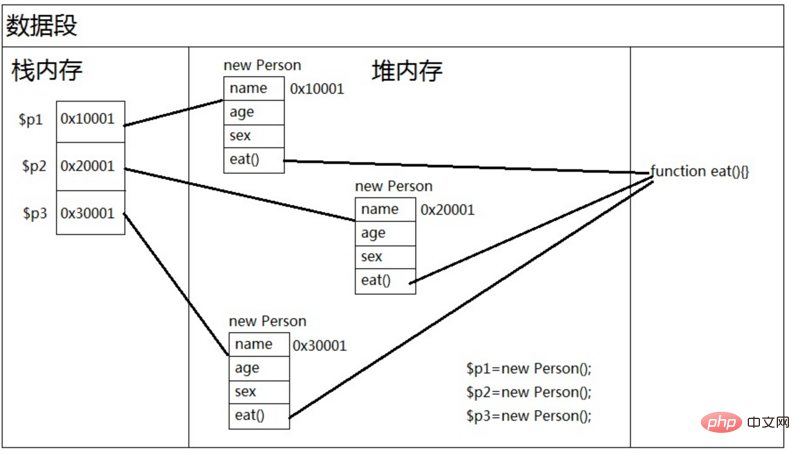
This article brings you an introduction to factory mode and memory allocation, as well as the connection between factory mode and memory allocation. It has certain reference value. Friends in need can refer to it. I hope it will be helpful to you.
#1. The factory pattern is a class or method responsible for producing other objects. Commonly used factories A usage of the pattern:
<?php class ExportIndustryObj{
public $_obj;
public function getObj(){
if(!$this->_obj){
$this->_obj = new Test();
}
return $this->_obj;
}
}
class Test{
public function __construct(){
echo 121111;
}
}
$industry = new ExportIndustryObj();
$obj1 = $industry->getObj();
$obj2 = $industry->getObj();
var_dump($obj1,$obj2);2. After the above code is executed:

(1)代码中输出了两个对象,分部是$obj1和$obj2,输出了一次construct中的数字,两个对象编号一样 (2)由此可见,工厂模式可以做到一点,就是只new一次对象
Stack space segment is a place to store data types that occupy the same space length and occupy less space, such as integers 1, 10, 100, 1000, 10000, 100000, etc. Wait, the space occupied in the memory is the same length, both are 64 bits and 4 bytes.
3,Heap space segment is a data type that stores data of variable length and takes up large space, such as objects.
4,Code segment is where the executable program code itself is stored.
5,Data segment is a global variable that stores initialization and is not 0, such as static variables and constants.
6. Memory allocation diagram:
the object itself is placed in the heap, but the object name It is placed in the stack, so that the object can be used through the object name
9. Illustration of the object:
PHP Tutorial"
The above is the entire content of this article, I hope it will be helpful to everyone's learning. For more exciting content, you can pay attention to the relevant tutorial columns of the PHP Chinese website! ! !The above is the detailed content of What is the connection between factory pattern and memory allocation?. For more information, please follow other related articles on the PHP Chinese website!